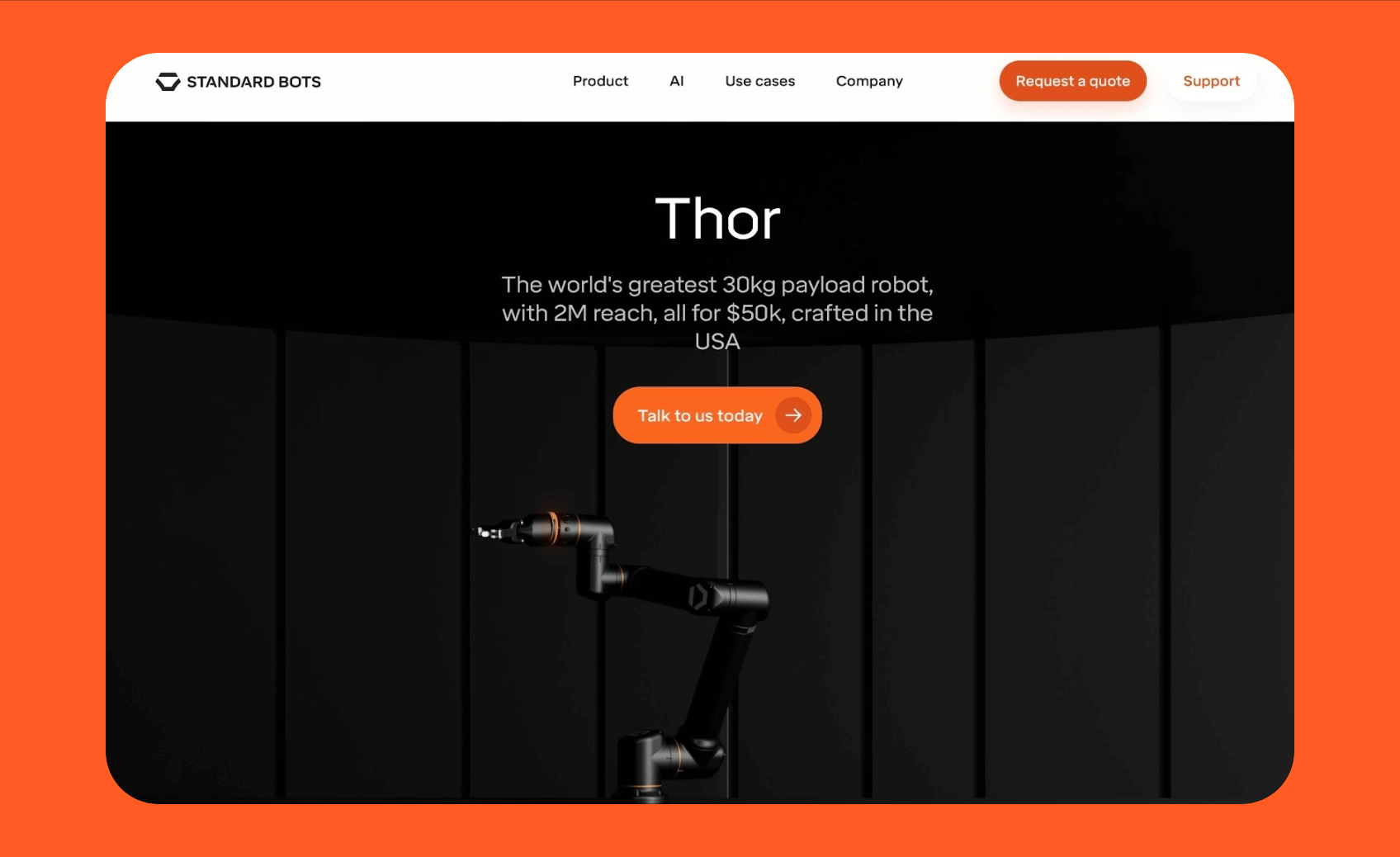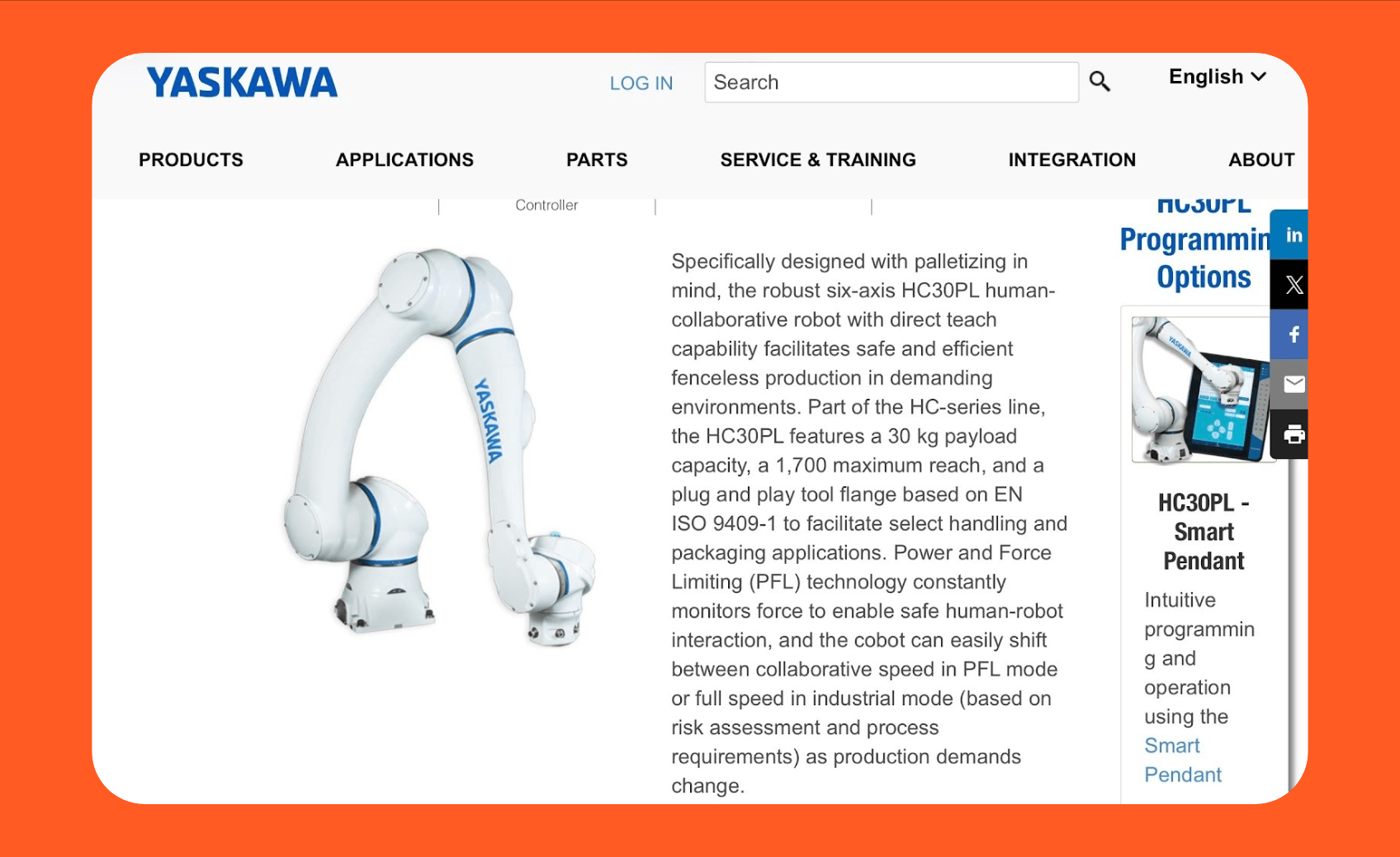Cobot palletizers, or cobots, work safely beside people, and they’re taking over the heavy work that used to mean long hours of lifting and stacking boxes. These easy-to-program cobots keep stacking even after the shifts are over.
According to Future Market Insights, the global palletizing robot market is expected to reach $2,673.5 million by 2035, as more manufacturers look for safer and more efficient ways to handle end-of-line packaging.
5 best cobot palletizers in 2025: TL;DR
What is a cobot palletizer?
A cobot palletizer is a collaborative robot system that automates the task of stacking products onto a pallet. These systems are designed to work safely alongside human workers, often without the need for extensive safety caging.
Unlike traditional palletizing robots, cobots use built-in sensors, force control, and vision systems to detect human presence and adjust their speed or stop when needed. This makes them ideal for small and mid-size production lines where space is limited and workers need to access the palletizing area.
They're easy to program through no-code interfaces, compact enough for tight layouts, and flexible enough to handle boxes, bags, or cartons of varying sizes. The result is reduced workplace injuries, lower labor costs, and continuous operation without the footprint or complexity of traditional robotic palletizing.
The 5 best cobot palletizers in 2025
1. Standard Bots Core: Best for plug-and-play palletizing

Standard Bots Core is built for manufacturers that want automation without complexity. It is a six-axis cobot designed to make palletizing quick and simple. With an 18kg payload and ±0.025mm repeatability, it stacks boxes and parts with high precision while working safely beside people.
Core fits well in small and mid-sized production spaces. It supports recipes for different pallet heights and product sizes to cut changeover time. Listed at $37,000 for the robot arm, it delivers industrial accuracy and reliability at nearly half the cost of a traditional palletizing robot.
Because Standard Bots designs both its hardware and software in-house, Core delivers a tightly integrated experience that simplifies setup and long-term maintenance.
2. Standard Bots Thor: Best for heavy-duty collaborative palletizing

Thor blends industrial power with collaborative safety. It supports up to 30kg payload, while fitting within a 296mm footprint, making it deployable in many existing lines. Its 2m reach is among the longest in the cobot class, letting it stack large or tall loads that smaller robots can’t reach.
Built on a six-axis architecture, Thor delivers smooth, precise motion. Its ±0.025mm repeatability ensures every layer remains stable under load. The arm supports IP69K rating, enabling it to survive harsh factory environments and high-pressure washdowns.
Safety and ease are baked in: Thor includes joint torque sensing, real-time force detection, collision response, and integrated vision for human presence awareness. Its programming interface is designed for simplicity, so you can teach tasks without extensive coding.
3. Universal Robots UR20: Best for long reach stacking

The Universal Robots UR20 feels like the next step in collaborative palletizing. It can reach up to 1.75m and lift 25kg, making it perfect for tall pallets or wide conveyors where smaller cobots struggle to keep up. The movements are smooth and controlled, so even at full stretch, UR20 keeps every placement steady.
UR20 is slim enough to squeeze into tight spaces and smart enough to slow or stop if someone steps near. It can handle boxes of different sizes and materials without constant reprogramming, keeping production moving with fewer interruptions.
4. Doosan Robotics P Series: Best for precision palletizing

The Doosan Robotics P Series is designed for tasks where accuracy and consistency matter most. Every joint in this cobot is equipped with built-in torque sensors, allowing it to handle delicate or irregular packages without crushing or misplacing them.
Doosan’s P Series comes with smooth motion control that gives operators confidence when stacking mixed products, fragile materials, or cartons that need gentle handling.
Beyond accuracy, the P Series delivers strong performance for its size, supporting payloads up to 30kg with 2.03m reach. Its advanced safety systems meet global collaborative standards, allowing it to work side by side with people safely.
5. Yaskawa HC30PL: Best for industrial-grade collaborative stacking

The Yaskawa HC30PL is built for factories that need the durability of an industrial robot with the safety and flexibility of a cobot. It offers a 30 kg payload and a 1.7 m reach, allowing it to move heavier boxes or large cartons that most cobots cannot manage.
HC30PL’s sturdy build and smooth six-axis motion make it reliable for long production runs and continuous palletizing. The easy teach pendant interface helps operators program new stacking layouts with minimal effort.
Although Yaskawa does not publish official prices, the HC30PL typically falls into the higher range of industrial cobots due to its size and heavy-duty build. For manufacturers looking for a cobot that performs like a full-scale industrial system, the HC30PL delivers dependable, long-term value.
Why manufacturers are choosing collaborative palletizers
Manufacturers choose collaborative palletizers for their space-efficient design, safe operation, and quick ROI. These cobot palletizing applications run nonstop, are easy to program, and adapt fast to any layout or product change.
- Space-efficient design: Compact footprints fit smaller factories or tight layouts.
- Continuous productivity: They run around the clock, stacking consistently with minimal downtime.
- Safe to work around: Built-in sensors and force control let cobots operate beside humans without cages or barriers.
- Faster ROI: Most systems pay for themselves within 12 to 24 months by cutting labor costs and reducing injuries.
- Easy to program: No-code or low-code software allows quick setup and pattern changes without outside help.
- Flexible deployment: Cobots move easily between lines or adjust to new products in a few hours.
How cobot palletizing works
A cobot palletizer works by combining sensors, vision systems, and robotic control software to pick, place, and stack items automatically. Each component plays a specific role in keeping the process accurate and safe while adapting to different product types and pallet patterns.
- Detection: Cameras or proximity sensors identify incoming boxes on the conveyor and calculate their position and orientation.
- Picking: The robot arm uses a gripper or vacuum tool to lift each box smoothly, maintaining balance and avoiding product damage.
- Stacking: It follows a programmed pallet pattern, layering products precisely to ensure stability and maximize pallet space.
- Adjustment: The system automatically adapts to varying box sizes, weights, or pallet heights without manual intervention.
- Safety response: When a person enters the working zone, the cobot senses proximity and slows or pauses its movement to avoid contact.
- Smart control: Built-in AI or motion algorithms help optimize speed, minimize travel paths, and maintain consistent performance through long shifts.
Cost and ROI expectations
The cost of cobot palletizers is around $25,000 to $150,000. It is based on payload, reach, and integration level, and most systems now deliver faster ROI than traditional industrial robots.
Across live deployments, Standard Bots’ cobots have already helped manufacturers cut repetitive lifting hours and boost uptime without expensive integration work.
Summing up
Cobot palletizers are quickly becoming the go-to solution for manufacturers looking to modernize without major disruption. They combine precision, safety, and flexibility in one package. This reduces strain on workers and improves efficiency across packaging and shipping lines.
With simple setup, redeployment between stations, and payback in under two years, these robots offer clear value for both small workshops and large-scale plants.
As labor shortages and production demands continue to rise, collaborative palletizers stand out as a practical, human-friendly step toward full automation. They prove that smart robotics does not have to be complex or expensive to deliver real results on the factory floor.
Next steps with Standard Bots’ robotic solutions
Standard Bots Core and Thor are ideal six-axis cobot additions to palletizing operations, combining precision, flexibility, and safety without the need for large robotic cells.
- Affordable and adaptable: Core lists at $37k and Thor at $49.5k, delivering high-accuracy automation at nearly half the cost of traditional palletizing systems.
- Precision and power: With ±0.025 mm repeatability, Core’s 18 kg payload and Thor’s 30 kg payload easily handle boxes, bags, and bulk items across different pallet patterns.
- AI-driven simplicity: Equipped with advanced demonstration learning and real-time adaptation through Standard Bots' vertically integrated AI platform, Core and Thor integrate smoothly with palletizing operations for flexible automation.
- Safety-first design: Built-in vision and collision detection allow Core and Thor to work safely beside human operators in open production areas.
Schedule your on-site demo with our engineers today and see how Standard Bots Core or Thor can automate palletizing in your facility with unmatched accuracy and efficiency.
FAQs
1. What’s the difference between a cobot palletizer and an industrial palletizing robot?
The main difference between a cobot palletizer and an industrial palletizing robot is how they interact with people and the workspace they require. A cobot palletizer is designed to work safely beside human operators without needing cages or barriers. Industrial palletizing robots are built for speed and heavy payloads, which means they must operate in enclosed cells for safety.
2. How do Core and Thor differ in size and application?
Standard Bots Core and Standard Bots Thor differ mainly in payload capacity, reach, and intended application. Core offers an 18kg payload and compact design for light to medium palletizing work. Thor, on the other hand, handles a 30kg payload and has a stronger build for heavier loads, larger boxes, and longer production runs.
3. What kind of payloads can a collaborative palletizer handle?
A collaborative palletizer can handle payloads ranging from 5kg to 30kg, depending on the model. Entry-level cobots are best for lightweight packaging or assembly tasks, while mid-range models like Standard Bots Core are designed for up to 18kg of lifting capacity.
4. Can cobot palletizers work 24 hours a day without supervision?
Yes, cobot palletizers can operate 24 hours a day when properly set up and maintained. Once programmed, they perform repetitive palletizing tasks with consistent accuracy through multiple shifts. Their integrated sensors monitor motion, pressure, and placement, automatically adjusting for product changes or misalignments.
5. How safe are collaborative robot palletizers near humans?
Collaborative robot palletizers are extremely safe to operate near humans because they are designed specifically for shared workspaces. They use torque sensors, vision systems, and force-limiting technology to recognize when a person is nearby and automatically slow down or pause movement.
6. What ROI can manufacturers expect from a palletizing cobot?
The return on investment (ROI) for a palletizing cobot generally falls between 12 and 24 months, depending on production scale, product mix, and operating hours. Manufacturers typically see savings from reduced labor costs, fewer injuries, and higher uptime.
brighter future
Join thousands of creators
receiving our weekly articles.








.png)

